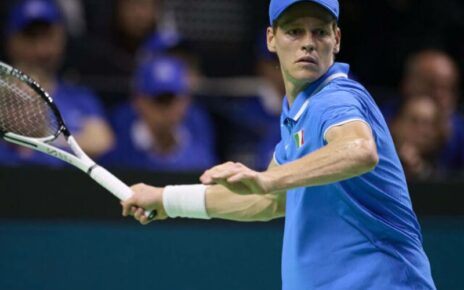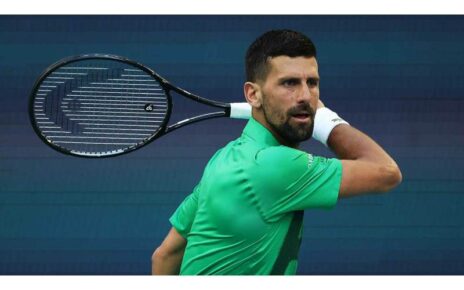Osaka shared some thoughts at a press conference after losing to 18-year-old Lela Fernandes of Canada on Friday night.
New York-Naomi Osaka looked at her agent and said she wanted to tell the world what the two of them privately discussed in the Arthur Shey Stadium hallway after she ended up defending the US Open title with racket-tossing, composer-missing, lead. -Evaporation of defeat in the third round.
His answer: “Of course.”
And then Osaka, every time her voice caught her words and her eyes filled with tears, he said Friday night that she was thinking of taking a break from tennis.
“I feel like, lately, when I win, I don’t feel happy, I feel more relaxed. And then when I lose, I feel very bad,” Osaka said at her press conference after 5-7, 7-6 (2), Lela Fernandes, an 18-year-old Canadian who is ranked 73rd and has never been to a Grand Slam event before, lost 6-4 in Flushing Meadows. “I don’t think that’s normal.”
The moderator in charge of the session with reporters tried to cut things off, but Osaka said she wanted to continue.
“It’s very hard to explain,” she said, holding her left cheek in her hand. “Basically, I think I’m kind of in the moment where I’m trying to figure out what to do and I honestly don’t know when I’m going to play my next tennis match.”
Crying, she lowered the black visor over her eyes and apologized, then slapped her palms on both cheeks.
“Yeah,” Osaka woke her up as she left, “I think I’m going to take a break from playing for a while.”
The 23-year-old Osaka had her first slam tournament as she took a mental health break after being knocked out of the French Open before the second round as she announced she would not be attending news conferences in Paris.
She also sat at Wimbledon before competing in the Tokyo Olympics, where she lit a cauldron as one of Japan’s most famous athletes.
Osaka has four Grand Slam titles, including the US Open in 2018 – Serena Williams in a tumultuous final – and a year ago, as well as two more on the hard court of the Australian Open. When she took a break after Roland Garros, she revealed that she endured waves of anxiety before meeting the media and suffered from depression for three years.
Over the past week, Osaka has written on social media, talking about the importance of self-confidence and her thoughts on how to ignore the expectations of others.
The first sign that things were not completely right with Osaka came on Friday when she exploded her racket against the court after dropping a point. Moments later, Osaka broke her equipment, bounced it off and went halfway into the net. Then came a full-on spike near the baseline.
Later, she compared that behavior to “childish” behavior.
“I was telling myself to calm down, but I think there might be a boiling point,” Osaka said. “Like, in general, I think I like challenges. But lately when things don’t go my way, I’m very worried and I think you can feel it.”
Her game was off. Her play face was gone. Eventually, the crowd was blabbering on about getting her back on the court and taking too much time in points.
Soon, the No. 3-seeded Osaka came out of the bracket.
There was such excitement on the day: Earlier in the Ashes, another 18-year-old from the region surprisingly removed the No. 3 seed, when Spain’s Carlos Alcarz defeated French Open runner-up Stefanos Tsitipas 6-3, 4-6, -6–6 (2), 0–6, -6- ((5) 19 in Michael to become the youngest man in the fourth round at Flushing Meadows after Michael Chang and Pete Sampras.
The Osaka Major came with a 16-match winning streak. Still, Fernandes declared: “Before the match, I knew I could win.”
For Osaka, perhaps moving away from high-level competition was an issue.
Another possible factor in her failure to close everything out with a 5-5 victory over left-hander Fernandes in the second set: Osaka had not played a single match since Monday. The usual day-to-day holiday rhythm in the Slams was disrupted as Osaka Bai was scheduled to meet in the second round, Olga Danilovic, due to illness.
“I’ve never had a walkover at the Grand Slam, so it was definitely a weird feeling,” Osaka said.
Osaka was very good in the opening set on Friday. She scored 12 of 13 points with the last nine, a break in love to go 6-5 and stopping love with the help of a pair of aces at 112 mph and 114 mph.
Felt on track for a similar conclusion in the second set, 6-5 lead and serving. But when Osaka made the forehand wide, Fernandes made the first break of the match 6-all.
“Finally, I found a pattern for her service,” Fernandes said. “I just trusted my gut and hit the ball.”
And thus began the lower cycle of Osaka. She trailed 5-0 in the upcoming tiebreaker, losing shots and sometimes displaying her frustration as she has done in the past वून blowing up her racket.
Chair umpire Alison Hughes did not approve of Osaka at the time, although he was later warned to hit the ball in the stands.
“I didn’t really focus on Naomi,” Fernandes said. “I was just focused on myself, on my game, on what I wanted to do.”
More importantly, Osaka was not her best. After the second set, she left the court with a white towel covering her head, then sat on her changeover chair in the same block-out-of-the-world manner.
Fernandes, smiling and holding her right fist overhead after the highest score, certainly had something to do with the result.
She scored 18 of the first 19 points आणि and never faced a breakpoint मध्ये in the third set.
From Fernandes’ knees to the ground, the fast-paced style is reminiscent of another leftist, Angelique Kerber, the three-time Grand Slam champion who won the 2016 US Open.
And who will be Fernandes’ next rival?
“I’m going to do a show like I did tonight, and we’ll see how it goes,” Fernandes said.




